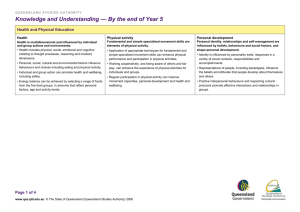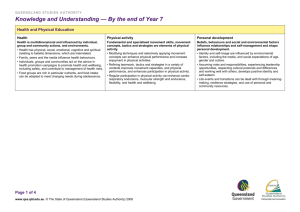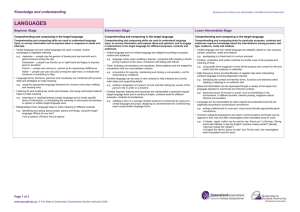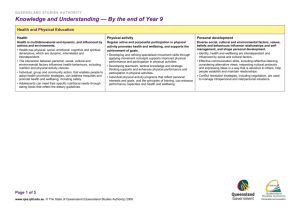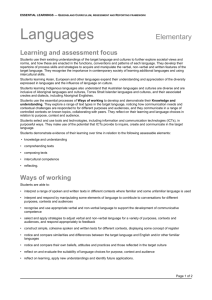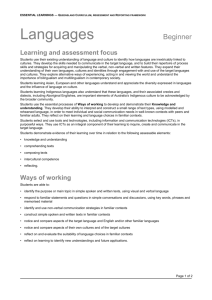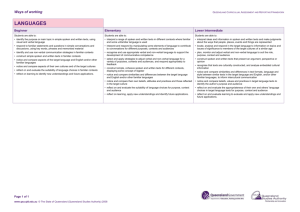DOCX, 53 kB
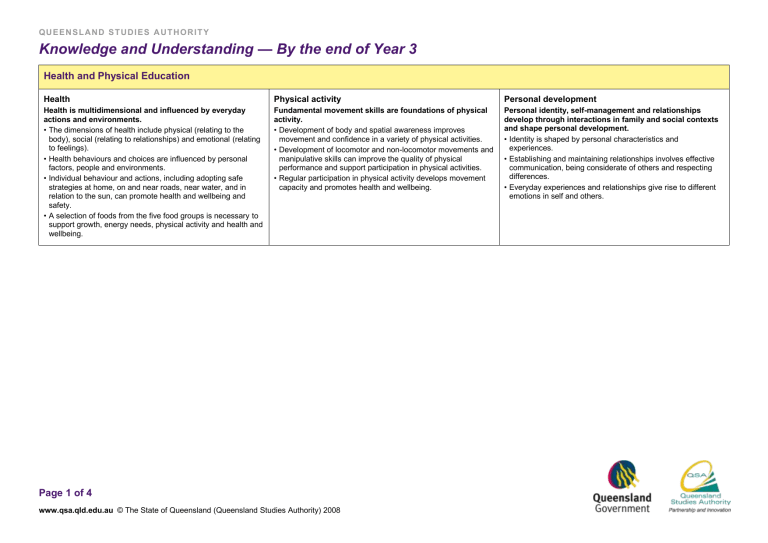
Q U E E N S L A N D S T U D I E S A U T H O R I T Y
Knowledge and Understanding
— By the end of Year 3
Health and Physical Education
Health
Health is multidimensional and influenced by everyday actions and environments.
• The dimensions of health include physical (relating to the body), social (relating to relationships) and emotional (relating to feelings).
• Health behaviours and choices are influenced by personal factors, people and environments.
• Individual behaviour and actions, including adopting safe strategies at home, on and near roads, near water, and in relation to the sun, can promote health and wellbeing and safety.
• A selection of foods from the five food groups is necessary to support growth, energy needs, physical activity and health and wellbeing.
Physical activity
Fundamental movement skills are foundations of physical activity.
• Development of body and spatial awareness improves movement and confidence in a variety of physical activities.
• Development of locomotor and non-locomotor movements and manipulative skills can improve the quality of physical performance and support participation in physical activities.
• Regular participation in physical activity develops movement capacity and promotes health and wellbeing.
Personal development
Personal identity, self-management and relationships develop through interactions in family and social contexts and shape personal development.
• Identity is shaped by personal characteristics and experiences.
• Establishing and maintaining relationships involves effective communication, being considerate of others and respecting differences.
• Everyday experiences and relationships give rise to different emotions in self and others.
Page 1 of 4
www.qsa.qld.edu.au
© The State of Queensland (Queensland Studies Authority) 2008
Q U E E N S L A N D S T U D I E S A U T H O R I T Y
Knowledge and Understanding
— By the end of Year 3
Languages
Beginner Elementary Lower Intermediate
Comprehending and composing in the target language
Comprehending and composing skills are used to understand language input, to convey information and to express ideas in response to needs and interests.
• Verbal language and non-verbal language are used in simple, routine exchanges to negotiate meaning.
• Language forms, functions, grammar and vocabulary are combined with process skills and strategies to make meaning.
• Listening for and locating key words and phrases, and using memorised material helps to make meaning.
• Manipulating known language helps to make meaning in different contexts.
Intercultural competence and language awareness
Noticing and comparing similarities and differences between languages and cultures informs intercultural communication.
• Learning languages provides insights into one’s own languages and the target language, and how concepts are expressed across languages.
• Ways of using language provide information about cultures.
• Languages and cultural practices have particular features, conventions, patterns and practices that may be similar to or different from one’s own language and culture.
Comprehending and composing in the target language
Comprehending and composing skills are used to understand language input, to convey information and express ideas and opinions, and to engage in interactions in the target language for different purposes, contexts and audiences.
• Verbal language and non-verbal language are adapted according to purpose, context and audience.
• Texts, including conversations and narratives, follow patterns and are shaped by conventions that can vary between cultures.
• Familiar language can be used in new contexts to help interpret and convey main ideas and supporting details.
• Familiar linguistic features and structures are manipulated to generate original target language texts and to construct simple, cohesive texts for different purposes, contexts and audiences.
Comprehending and composing in the target language
Comprehending and composing texts for particular purposes, contexts and audiences requires knowledge about the interrelations among purpose, text type, audience, mode and medium.
• Verbal language and non-verbal language are adapted, based on role, purpose, context, audience, mode and medium.
• Context, vocabulary and syntax combine to provide cues to the purpose and meaning of texts.
• High-frequency forms and identification of register help when interpreting complex language involving dependent clauses.
• Ideas and information can be expressed through a variety of text types and language adjusted to suit formal and informal contexts.
• Language can be manipulated to make original and extended texts that are organised according to sociocultural conventions.
• Common colloquial expressions are used in communication and these can be regional in their use and often meaningless when translated word for word.
Intercultural competence and language awareness
Intercultural competence and knowledge of languages and cultures allow for exploration of different ways of experiencing and acting in the world.
• Ideas or information may or may not be transferable from one language to another and can provide cultural insights and information.
• Cultural practices in the target language can be compared with those of other cultures and connections noticed between language use and cultural knowledge and behaviour.
• Investigations into language use and cultural beliefs, attitudes and practices further develop intercultural competence.
Intercultural competence and language awareness
Intercultural competence and knowledge of languages and cultures allow for differing ways of experiencing, acting in and viewing the world.
• Regional and social diversity exists within and across languages and cultures, and this diversity informs appropriate communication.
• Familiarity with issues and topics of significance to members of the target culture enhances intercultural communication.
• Beliefs, values and attitudes are embedded in languages and cultures; and knowledge of these aspects can facilitate intercultural communication.
Page 2 of 4
www.qsa.qld.edu.au
© The State of Queensland (Queensland Studies Authority) 2008
Q U E E N S L A N D S T U D I E S A U T H O R I T Y
Knowledge and Understanding
— By the end of Year 3
Studies of Society & Environment
Time, continuity and change
Changes and continuities are identified through events, people’s contributions and the stories of local communities.
• Aboriginal people’s and Torres Strait Islander people’s continuous association with the land and the sea can be seen in stories and events that pre-date European colonisation.
• Contributions of individuals and groups to communities can be identified by symbols and stories.
Place and space
Local natural, social and built environments are defined by specific features and can be sustained by certain activities.
• Local environments are distinguished by natural features, places of importance to particular groups, and public spaces.
• Resources and environments can be used, conserved and protected by valuing and applying sustainable practices
• Maps have symbols to represent places and identify the relative position of features including landmarks and locations.
Culture and identity
Local communities have different groups with shared values and common interests.
• Groups and communities are identified by practices, symbols and celebrations that reflect their values, beliefs and sense of belonging.
• Aboriginal peoples and Torres Strait Islander peoples are Australia’s Indigenous peoples and their influences are evident and valued in
Australian communities.
• Stories about significant events and individuals reflect cultural diversity in local and other Australian communities.
• Citizenship involves belonging to groups and communities and valuing different contributions and behaviours such as caring for other members.
Political and economic systems
Communities have systems to make rules and laws, govern, and manage the production and consumption of goods and services.
• Rights and responsibilities, rules and codes of behaviour are part of local communities.
• Democratic decision-making systems help people to live and work together in communities.
• Voting is used to make decisions and select leaders in democratic systems.
• Australians are connected to other people and places by shared interests, including travel, exchanging goods and services, and environmental issues.
• People and resources are involved in the production and consumption of familiar goods and services.
Page 3 of 4
www.qsa.qld.edu.au
© The State of Queensland (Queensland Studies Authority) 2008
Q U E E N S L A N D S T U D I E S A U T H O R I T Y
Knowledge and Understanding
— By the end of Year 3
The Arts
Dance
Dance involves using the human body to express ideas, considering particular audiences and particular purposes, through dance elements in movement phrases.
• Gross motor movements, including locomotor and non-locomotor, are used to create actions for movement phrases.
• Directions, levels, shapes and pathways are used to move in space within movement phrases.
• Fast and slow movements are used to change timing in movement phrases.
• Percussive and sustained movement qualities are used to change energy in movement phrases.
• Structuring devices, including repetition and narrative forms, are used to organise movement phrases.
Drama
Drama involves using dramatic elements and conventions to express ideas, considering particular audiences and particular purposes, through dramatic action based on real or imagined events.
• Role can be established using movement, voice, performance space, cues and turn-taking
• Purpose and context are used to shape roles, language, place and space to express ideas.
• Dramatic action is structured by being in role and building storydramas.
Technology
Media
Media involves constructing meaning by using media languages and technologies to express representations, considering particular audiences and particular purposes.
• Still and moving images, sounds and words are used in media texts.
• Media techniques and practices, including crop, print, record/capture and sequence images, sounds and words, are used to create media texts.
• Representations in media texts can be either real or imagined, and are created for particular audiences and purposes.
Music
Music involves singing, playing instruments, listening, moving, improvising and composing by selecting the music elements to express ideas, considering different audiences and different purposes, through sound.
• Duration, beat, time values and metre are used to create repeated rhythmic patterns.
• Pitch and intervals are used to create melodic phrases and sequences.
• Repetition is used to structure music.
• Familiar sound sources, including vocal and instrumental sources, have characteristic sound qualities
(tone colour).
• Relative softness and loudness of sounds are used to change the dynamic level of music.
Visual Art
Visual Art involves selecting visual arts elements, concepts, processes and forms (both 2D and
3D) to express ideas, considering different audiences and different purposes, through images and objects.
• Warm (red, orange, yellow) and cool (blue, green, purple) colour schemes, and mixed and complementary colours, are used to create tone and variation.
• Line is used to suggest movement and direction.
• Regular, irregular, open, enclosed, overlapped and adjacent shapes are used to create categories and position.
• Texture is used to create variation and repetition.
Technology as a human endeavour
Technology is part of our everyday lives and activities.
• Products include artefacts, systems and environments.
• Designs for products are influenced by purpose, audience and availability of resources.
• Technology and its products impact on everyday lives in different ways.
Information, materials and systems (resources)
Resources are used to make products for particular purposes and contexts.
• Resources have characteristics that can be matched to design requirements.
• Simple techniques and tools are used to manipulate and process resources.
Page 4 of 4
www.qsa.qld.edu.au
© The State of Queensland (Queensland Studies Authority) 2008
